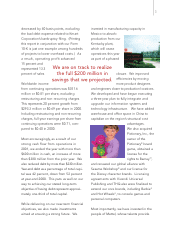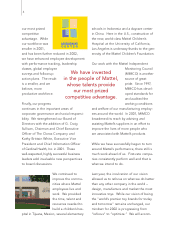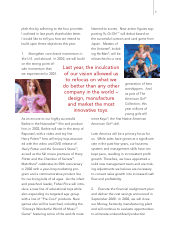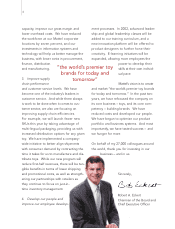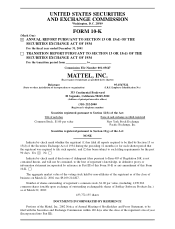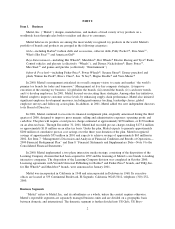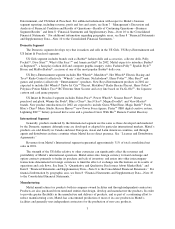Mattel 2001 Annual Report Download - page 14
Download and view the complete annual report
Please find page 14 of the 2001 Mattel annual report below. You can navigate through the pages in the report by either clicking on the pages listed below, or by using the keyword search tool below to find specific information within the annual report.Mattel’s products are sold throughout the world. Products within the Domestic segment are distributed
directly to large retailers, including discount and free-standing toy stores, chain stores, department stores, other
retail outlets and, to a limited extent, wholesalers. Mass merchandisers, such as Wal-Mart and Target, continue
to increase their market share. Products within the International segment are sold directly in Canada and most
European, Asian and Latin American countries, and through agents and distributors in those countries where
Mattel has no direct presence.
During the year ended December 31, 2001, Mattel’s three largest customers, Wal-Mart, Toys ‘‘R’’ Us and
Target, accounted for approximately 50% of consolidated net sales. See Item 7 ‘‘Management’s Discussion and
Analysis of Financial Condition and Results of Operations—Factors That May Affect Future Results’’ and Item
8 ‘‘Financial Statements and Supplementary Data—Note 8 to the Consolidated Financial Statements.’’
In the International segment, there is also significant concentration of sales to certain large customers. The
customers and the degree of concentration vary depending upon the region or nation.
Licenses and Distribution Agreements
Mattel has license agreements with third parties that permit Mattel to utilize the trademark, character, or
inventions of the licensor in product lines that Mattel manufactures. A number of these licenses relate to
product lines that are significant to Mattel’s business and operations. An important licensor is Warner Bros.,
which licenses the Harry Potterbook and movie property for use on Mattel’s products. Mattel also has
entered into license agreements with, among others: Disney Enterprises, Inc., relating to classic Disney
characters such as Mickey Mouse, Winnie the Poohand the Disney Princesses; Sesame Workshop relating to
its Sesame Streetproperties; Viacom International, Inc. relating to its Nickelodeonproperties; and Lyons
Partnership, L.P. relating to Barney, the purple dinosaur, as well as Barneyfor Baby, for infant and
preschool toys, feature plush, electronic learning aids, games and puzzles. In November 2001, Mattel entered
into a license agreement with Nihon Ad Systems Inc. for the master toy license to the Yu-Gi-Oh!property
worldwide, excluding Asia, for a term of four years, which includes the categories of action figures, vehicles,
activity toys, games and puzzles.
Royalty expense during the years ended December 31, 2001, 2000 and 1999 was approximately $220
million, $259 million and $220 million, respectively. See ‘‘Product Design and Development’’ and Item 8
‘‘Financial Statements and Supplementary Data—Note 7 to the Consolidated Financial Statements.’’
Mattel also licenses a number of its trademarks, characters and other property rights to others for use in
connection with the sale of non-toy products that do not compete with Mattel’s products, in particular for
consumer software products. Mattel distributes some third party finished products that are independently
designed and manufactured.
Trademarks, Copyrights, and Patents
Most of Mattel’s products are sold under trademarks, trade names and copyrights and a number of those
products incorporate patented devices or designs. Trade names and trademarks are significant assets of Mattel
in that they provide product recognition and acceptance worldwide.
Mattel customarily seeks patent, trademark or copyright protection covering its products, and it owns or
has applications pending for US and foreign patents covering many of its products. A number of these
trademarks and copyrights relate to product lines that are significant to Mattel’s business and operations. Mattel
believes its rights to these properties are adequately protected, but there can be no assurance that its rights can
be successfully asserted in the future or will not be invalidated, circumvented or challenged.
6



